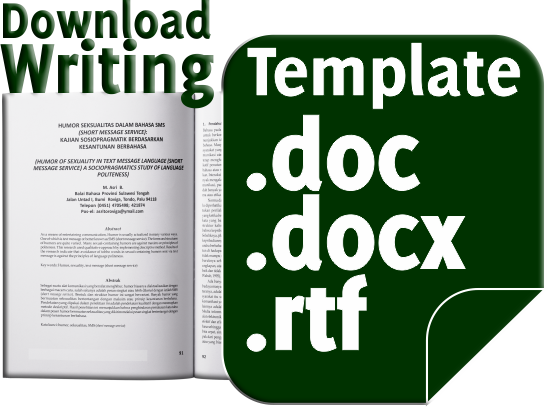Communicator Authenticity and Writing Motivation of University Students on Social Medium
Abstract
This research is accomplished to understand the triggers of the university students’ motivation in writing through social medium networks which is suspected by writing-matrix project, it is wellknown as ‘communicator authenticity’ which provides an authentic textual interaction. It is realized that the frequency of students’ writing activity on social media is a wonderful phenomena if it is compared to their writing activity in the classroom. This qualitative descriptive research used questionnaire as the instrument in collecting the data, which are then analyzed by applying theory of emotion, motivation, and computerized learning media. This research concluded that communicator authenticity is not the only trigger of students’ motivation to write on social medium, but the value and the meaning given by the students toward the social media itself that play an important role. Features, easiness, and emotional fulfillment to write are the other triggers which motivate students to write frequently on the social media. The academic significance of this research shows an opportunity for the lecturer to increase students writing motivation in the classroom-based writing activity or in the other academic contexts.
References
Bold, C. 2004. Supporting Learning and Teaching. David Fulton Publisher Ltd.
Cacioppo, J. T. And Berntson, G. G. 2007. “Affective Distinctiveness: Illusory or Real?”. Cognition & Emotion, 21: 6, 1347-1359
Deci, E.L., Vallerand, R. J., Pelletier, L. G., and Ryan, R.M. 1995. “Motivation and Education: The Self-Determination Perspective”. Educational Psychologist, 26 (3&4), pp.325-346.
Dickinson, L. 1995. “Autonomy and Motivation: A Literature Review”. System. Vol. 23, No. 2, pp. 165-174
Frijda, N. H. 1988. “The Laws of Emotion”. American Psychological Association. May, 1988. Vol. 43, No. 5, pp.349-358
Hong, F. 2006. “Students’ Perception of Peer Response Activity in English Writing Instruction”. CELEA (Bimonthly) Aug. 2006. Vol. 29, No. 4
Lee, M. J. 2008. “Using Blogs as ePortfolios in ESL/EFL Writing Classes”. The Newsletter of TESOL’s Second Language Writing Interest Section. 2008. Vol.3 No. 2
Lewis, M., Jones, J. M. H., and Barrett, L.F. 2008. Handbook of Emotions. The Guilford Press
Noback, et al. 2005. The Human Nervous System: Structure and Function. Sixth Edition. Humana Press.
Pinkman, K. 2005. “Using Blogs in the Foreign Language Classroom: Encouraging Learner Independence”. The JALT CALL Journal, 2005, Vol. I, No. I, pp.12-24.
Ryan, R.M., and Deci, E.L. 2000. “Intrinsic and Extrinsic Motivation: Classic Definitions and New Directions”. Contemporary Educational Psychology. 25, pp. 54-67 (2000).
Stevens, et al. 2008. “Writingmatrix: Connecting Students with Blogs, Tags, and Social Networking”. TESL-EJ. March 2008, Vol. 11, No. 4
Urkuhart, V dan McIver, M. 2005. Teaching Writing in Content Areas. McREL.
Williams, J. 2005. Teaching Writing in Second and Foreign Language Classroom. McGrawHill.

Copyright (c) 2016 Zainurrahman Zainurrahman

This work is licensed under a Creative Commons Attribution-NonCommercial-ShareAlike 4.0 International License.


